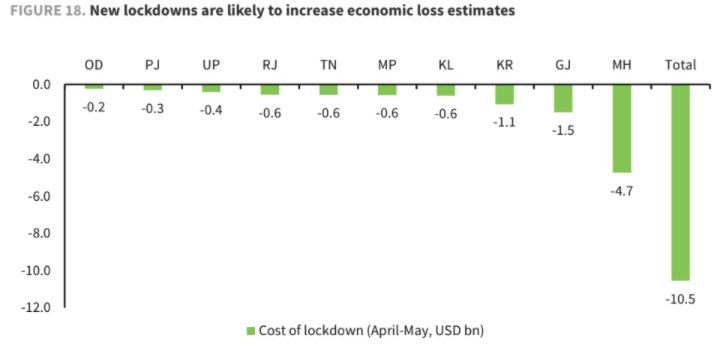The economic cost of the latest shutdowns in India will increase to $1.25 billion per week, from $0.52 billion earlier. This increase reflects a modest tightening of activity curbs, and the widening geographical spread of the second wave, says a report from Barclays.
The report authored by Rahul Bajoria and Shreya Sodhani titled ‘India: Tracking COVID-19 and Vaccines 2020 redux?’ says that if the current restrictions remain in place until the end of May, the cumulative loss of activity could amount to around $10.5 billion, or 0.34 percentage point (pp) of annual nominal GDP.
“However, the impact on Q1 FY2021-22 nominal GDP is likely to be higher, shaving 1.4pp from Q1 FY2021-22 nominal GDP. While we maintain our FY2021-22 real GDP growth forecast at 11.0% y/y, if the curbs are tightened further, then we see modest downside risks,” they said in the report.

Lockdowns: Slowing mobility, rising impact
State governments in India have begun to re-introduce lockdown measures, such as night curfews and weekend mobility restrictions, led by Maharashtra.
In India: Tracking COVID-19 and Vaccines: Two steps forward, one step back, March 22, 2021, Barclays report had noted that mobility restrictions in place for two months could cost the economy $5.2 billion in lost output, or 0.17pp of nominal GDP.
However, with case loads rising more broadly, and more states implementing greater mobility restrictions, the near-term economic damage could be higher, noted the report.
COVID-19 Second Wave
The biggest concern about the current wave has been the pace of the increase in daily cases. However, with better healthcare facilities and significant testing capacity, the test positivity rate has already started to moderate relative to previous cycles.
Further, cities like Mumbai, Pune, Delhi and Ahmedabad have experienced multiple mini cycles within the long first wave. While the number of new cases is unlikely to decline in the near term, Barclays expect the tightening of mobility restrictions and greater testing may start to have an impact on new cases in the next
few weeks.
The report said the number of new active cases is likely to stabilise in May, as recoveries catch up with new cases. This would be consistent with last year’s data, which saw active cases increase for 25 weeks between April and September 2020, followed by 21 weeks of consecutive decline up to mid February 2021.
While the current increase in active cases has only been for eight weeks, it is believed the cycle is starting to mature.
Vaccinations: The only path to redemption
India’s vaccination drive, which started on January 16 with healthcare workers, was expanded to include everyone above 45 years of age on April 1.
In the 86 days since the vaccine scheme began, India has administered more than 104 million shots, and 13 million people have been fully vaccinated with double doses.





